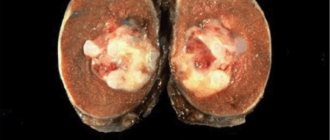Migraine pain occurs due to swelling of an area of the brain
, which is caused by a sharp narrowing (spasm) and then expansion of its vessels.
According to statistics, in most cases, migraine affects the young population
(under 30 years of age).
And most often this terrible disease falls on the fragile shoulders of the weaker sex, although in childhood it is more common in boys. After 60 years, the course of the disease becomes easier, but in middle years it reaches its peak
.
Causes of a migraine attack
Migraine occurs for various reasons:
- First of all, this is, of course, a genetic predisposition
(it is transmitted mainly through the female line, but is often found in men). - Migraines can also occur due to various types of brain injury
(for example, after a car accident).
The following factors contribute to the occurrence of an attack:
- sleep disturbances or deficiency;
- emotional stress, stress and fatigue;
- frequent consumption of coffee, chocolate and low-alcohol drinks (wine, beer, champagne).
Nonsteroidal anti-inflammatory drugs for migraine
The main goal of treating a migraine attack is to relieve the headache and associated symptoms. Successful relief of an attack makes the patient adherent to the prescribed treatment and improves his quality of life. Today, to treat a migraine attack, drugs of various pharmacological classes are used, which, to a greater or lesser extent, meet the above requirements [1] (Table 1).
Despite the wide choice of drugs for the treatment of migraine, there is still no complete agreement on their effectiveness. On the one hand, a large number of studies have been accumulated on this problem, and at the same time, only a few of them comply with the requirements of evidence-based medicine (GCP (Good Clinical Practice) standard) and the recommendations of the International Society for the Study of Headache. pain (The International Headache Society, IHS).
International European recommendations call non-steroidal anti-inflammatory drugs (NSAIDs) the drugs of choice for the relief of migraine attacks of mild and moderate intensity. Randomized clinical trials (RCTs) have been conducted on the effectiveness of acetylsalicylic acid [3–6], ibuprofen [7, 8], diclofenac [9–11], metamizole [12], phenazone [13], tolfenamic acid [14], paracetamol [15] . It has been shown that the combination of acetylsalicylic acid with paracetamol and caffeine is highly effective for migraine and has advantages over separately used components [16–18]. Intravenously administered acetylsalicylic acid relieves a migraine attack better than subcutaneously administered ergotamine [19]. The combination of acetylsalicylic acid with metoclopramide was as effective as sumatriptan [20]. Effervescent Aspirin (1000 mg), ibuprofen (400 mg) and sumatriptan (50 mg) were equally effective for migraine two hours after administration [21, 22]. A placebo-controlled study showed that diclofenac potassium in sachet form (50 and 100 mg) was as effective as sumatriptan (100 mg) in relieving migraine [10, 11]. The selective COX type 2 inhibitor valdecoxib (20–40 mg) also reduced migraine pain [23].
The European Federation of Neurological Societies (EFNS) recommends the use of NSAIDs for the treatment of migraine, the effectiveness of which has been proven in randomized, double-blind, placebo-controlled studies [24] (Table 2).
For the relief of migraine, NSAIDs with rapid accumulation in plasma (Tmax) and a short half-life (T1/2) are primarily recommended, which ensures rapid development of analgesia and the safety of the drug with repeated use. In recent years, modified forms of well-known NSAIDs have been created (diclofenac potassium salt (Voltaren Rapid), ibuprofen in the form of L-arginine salt (Faspic) and dexketoprofen trometamol (Dexalgin)) with modified physicochemical, pharmacodynamic and pharmacokinetic parameters to ensure rapid onset analgesia (Table 3).
The effectiveness of NSAIDs for migraine is associated with the suppression of neurogenic inflammation in the meninges. The anti-inflammatory activity of the drugs is realized due to the anti-exudative effect and the reduction of the allogeneic effect of inflammatory mediators. Antiexudative properties cause a reduction in inflammatory edema, which exerts mechanical pressure on tissue pain receptors. The inhibitory effect of these drugs on the production and activity of inflammatory mediators reduces the effect on nerve endings of such biologically active substances as substance P, calcitonin gene-related peptide (CGRP), prostaglandins, bradykinin, histamine, serotonin. It is important to note that inhibition of prostaglandin synthesis reduces the sensitization of pain receptors to the action of other chemical and mechanical stimuli caused by them. A decrease in prostaglandin biosynthesis correlates more with the analgesic effect of NSAIDs than with their anti-inflammatory effect.
In the central nervous system, NSAIDs have an analgesic effect by inhibiting the synthesis of prostaglandins (PGE1-, PGE2- and PGF2-alpha), which are involved in the transmission of pain information. It is believed that a decrease in the level of prostaglandins in the central nervous system causes pain suppression due to increased release of norepinephrine and an increase in its stimulating effect on alpha-adrenergic receptors. It has also been shown that the descending inhibitory serotonergic system is involved in the central analgesic effect of non-narcotic analgesics and NSAIDs and this action is realized, in particular, through serotonin receptors of the spinal cord and the sensory nucleus of the trigeminal nerve. In general, the analgesic activity of many NSAIDs against inflamed tissue is not inferior to the activity of narcotic analgesics [1, 2].
Acetylsalicylic acid has been used to treat pain for over 100 years. Currently used for the treatment of migraine attacks of mild to moderate intensity at a dose of 1000 mg. The maximum plasma concentration is observed after 1–2 hours. Gastrointestinal complaints (dyspepsia, ulcers, bleeding) are class-specific side effects for all NSAIDs, regardless of route of administration. Their frequency and severity depend on the daily dose, duration of use of acetylsalicylic acid and the presence of risk factors. Nausea, vomiting, gastralgia, diarrhea, erosive defects of the gastric and duodenal mucosa, even bleeding, are noted. In children under 12 years of age, taking Aspirin against the background of colds can provoke the occurrence of Reye's syndrome (acute toxic encephalopathy, accompanied by fatty degeneration of internal organs, mainly the liver and brain).
Paracetamol is not inferior to Aspirin in its pain-relieving activity. However, the effectiveness of the drug for migraines is lower than that of acetylsalicylic acid. This is due to the lack of anti-inflammatory action of paracetamol, and aseptic neurogenic inflammation of the dura mater is of key importance in the formation of pain syndrome in migraine. The maximum concentration in plasma is determined after 30–90 minutes. The rate of absorption slows down when ingesting food, antacids, or activated charcoal. The drug is low-toxic and has virtually no ulcerogenic activity. In rare cases, allergic reactions have occurred. With long-term use of high doses, hepatotoxic effects are possible.
Diclofenac (Voltaren) has an analgesic effect superior to many NSAIDs. Rapid and powerful analgesia occurs 15–30 minutes after intramuscular administration of diclofenac sodium salt (75 mg) and 15 minutes after oral administration of diclofenac potassium salt in the form of a sachet (Voltaren Rapid, 50 mg) [10]. A large randomized trial showed that the potassium salt of diclofenac was as effective as sumatriptan in the treatment of many migraine attacks [11] (Table 4). The maximum concentration of the drug in the blood after intramuscular administration of the sodium salt and when taking the potassium salt orally is observed after 20 minutes. With short-term use of Voltaren Rapid, side effects are minor and few [29].
Ibuprofen, naproxen, ketoprofen, ketorolac are well absorbed when taken orally. Among them, ketorolac has the most pronounced analgesia. The maximum concentration in plasma after taking ketorolac is observed after 30–34 minutes, ibuprofen and naproxen after 1–2 hours and 5 hours after taking ketoprofen. NSAID-induced gastroenteropathy occurs more often when using ketorolac, less often when using ibuprofen. With long-term use of ketorolac, the likelihood of liver and/or kidney dysfunction, as well as thrombocytopenia and anemia, increases.
Recently, in order to increase the effectiveness of treatment of a severe migraine attack, it has been proposed to combine NSAIDs and a triptan. It has been convincingly shown that a fixed combination of sumatriptan (50 mg) and naproxen sodium (500 mg) is more effective in relieving a migraine attack than monotherapy with these drugs [25]. Headache at 2 hours was reduced significantly more in patients receiving the fixed combination of sumatriptan and naproxen (65%) than in patients receiving sumatriptan (49%) or naproxen monotherapy (46%) (P < 0.01) (Table 4 ). Complete headache relief in this study was reported in 29% of those taking the fixed combination of sumatriptan and naproxen, 25% of those taking sumatriptan and 17% of those taking naproxen (P < 0.001). Smith TR et al. suggest that the advantage of the combination of a triptan and NSAIDs is due to the complex effect of these drugs on various mechanisms of the pathogenesis of a migraine attack. In 2007, a study was completed that confirmed the high effectiveness of a fixed combination of sumatriptan (85 mg) and naproxen (500 mg) in the treatment of migraine attacks [28]. This paper reports the results of two identically designed studies that show significant benefits of combining a triptan with an NSAID compared with either NSAID alone or placebo (Table 5).
Conclusion
The correct choice of drug for the effective treatment of an attack is a difficult task, the solution of which depends on the severity of the migraine attack, concomitant diseases, and past experience with the use of drugs. Conducted RCTs and our own experience allow us to formulate several provisions that will help increase the effectiveness of treatment of a migraine attack [1]:
- NSAIDs with modified physicochemical properties may be effective for migraine, like triptans.
- The combination of an NSAID and a triptan is more effective than the separate use of an NSAID or a triptan in the treatment of a migraine attack, since they act on different parts of the pathogenesis of the disease.
- If the patient cannot distinguish a migraine attack from a tension headache, then he should take an NSAID.
- If you experience severe nausea and vomiting, you should avoid taking NSAIDs and triptans by mouth. Intranasal, rectal, intravenous or intramuscular routes of administration are preferred.
Literature
- Amelin A.V., Ignatov Yu.D., Skoromets A.A., Sokolov A.Yu. Migraine. Pathogenesis, clinic, pharmacotherapy 2011, 264 p.
- Ignatov Yu. D., Kukes V. G., Mazurov V. I. Clinical pharmacology of non-steroidal anti-inflammatory drugs. M.: GEOTAR, 2010. 258 p.
- Chabriat H., Joire JE, Danchot J., Grippon P., Bousser MG Combined oral lysine acetylsalicylate and metoclopramide in the acute treatment of migraine: a multicentre double-blind placebo-controlled study // Cephalalgia. 1994; 14: 297–300.
- Nebe J., Heier M., Diener HC Low-dose ibuprofen in self-medication of mild to moderate headache: a comparison with acetylsalicylic acid and placebo // Cephalalgia. 1995; 15:531–535.
- Tfelt-Hansen P., Henry P., Mulder LJ, Scheldewaert RG, Schoenen J., Chazot G. The effectivenes of combined oral lysine acetilsalicylate and metoclopramide compared with oral sumatriptan for migraine // Lancet. 1995. Vol. 346. P. 923–926.
- Diener H. C., Bussone G., de Liano H. et al. Placebo controlled comparison of effervescent acetylsalicylic acid, sumatriptan and ibuprofen in the treatment of migraine attacks // Cephalalgia. 2004; 24:947–954.
- Havanka-Kanniainen H. Treatment of acute migraine attack: ibuprofen and placebo compared // Headache. 1989; 29:507–509.
- Kloster R., Nestvold K., Vilming ST A double-blind study of ibuprofen versus placebo in the treatment of acute migraine attacks // Cephalalgia. 1992; 12: 169–171.
- Karachalios GN, Fotiadou A., Chrisikos N., Karabetsos A., Kehagioglou K. Treatment of acute migraine attack with diclofenac sodium: a double-blind study // Headache. 1992; 32:98–100.
- Dahl FC, Bjrkman R. Diclofenac-K (50 and 100 mg) and placebo in the acute treatment of migraine // Cephalalgia. 1993; 13: 117–123.
- The Diclofenac-K/Sumatriptan Migraine Study Group. Acute treatment of migraine attacks: efficacy and safety of a nonsteroidal antiinflammatory drug, diclofenacpotassium, in comparison to oral sumatriptan and placebo // Cephalalgia. 1999; 19: 232–240.
- Tulunay FC, Ergun H., Gulmez SE et al. The efficacy and safety of dipyrone (Novalgin) tablets in the treatment of acute migraine attacks: a double-blind, crossover, randomized, placebo-controlled, multi-center study // Funct Neurol. 2004; 19: 197–202.
- Goebel H., Heinze A., Niederberger U., Witt T., Zumbroich V. Efficacy of phenazone in the treatment of acute migraine attacks: a double-blind, placebo-controlled, randomized study // Cephalalgia. 2004; 24:888–893.
- Myllyla V.V., Havanka H., Herrala L. et al. Tolfenamic acid rapid release versus sumatriptan in the acute treatment of migraine: comparable effect in a double-blind, randomized, controlled, parallel-group study // Headache. 1998; 38:201–207.
- Lipton RB, Baggish JS, Stewart WF, Codispoti JR, Fu M. Efficacy and safety of acetaminophen in the treatment of migraine: results of a randomized, double-blind, placebo-controlled, population-based study // Arch Intern Med. 2000; 160:3486–3492.
- Lipton RB, Stewart WF, Ryan RE, Saper J., Silberstein S., Sheftell F. Efficacy and safety of acetaminophen, aspirin, and caffeine in alleviating migraine headache pain—three double-blind, randomized, placebo-controlled trials. Arch Neurol. 1998; 55: 210–217.
- Diener HC, Pfaffenrath V., Pageler L. The fixed combination of acetylsalicylic acid, paracetamol and caffeine is more effective than single substances and dual combination for the treatment of headache: a multi-centre, randomized, double-blind, single-dose, placebo-controlled parallel group study // Cephalalgia. 2005; 25: 776–787.
- Goldstein J., Silberstein SD, Saper JR, Ryan RE Jr., Lipton RB Acetaminophen, aspirin, and caffeine in combination versus ibuprofen for acute migraine: results from a multicenter, double-blind, randomized, parallelgroup, single-dose, placebo- controlled study // Headache. 2006; 46:444–453.
- Limmroth V., May A., Diener HC Lysine-acetylsalicylic acid in acute migraine attacks // Eur Neurol. 1999; 41:88–93.
- Tfelt-Hansen P., Henry P., Mulder LJ, Scheldewaert RG, Schoenen J., Chazot G. The effectivenes of combined oral lysine acetilsalicylate and metoclopramide compared with oral sumatriptan for migraine // Lancet. 1995. Vol. 346. P. 923–926.
- Diener H. C., Eikermann A., Gessner U. et al. Efficacy of 1000 mg effervescent acetylsalicylic acid and sumatriptan in treating associated migraine symptoms // Eur Neurol. 2004; 52:50–56.
- Lampl C., Voelker M., Diener HC Efficacy and safety of 1000 mg effervescent aspirin: individual patient data meta–analysis of three trials in migraine headache and migraine accompanying symptoms // J Neurol. 2007; 254:705–712.
- Kudrow D., Thomas H. M., Ruoff G. et al. Valdecoxib for treatment of a single, acute, moderate to severe migraine headache // Headache. 2005; 45: 1151–1162.
- Evers S., Fra J., Frese A., Goadsby PJ, Linde M., May A., Sandor PS EFNS guideline on the drug treatment of migraine - revised report of an EFNS task force // European Journal of Neurology. 2009, 16, 968–981.
- Smith TR, Sunshine A, Stark SR et al. Sumatriptan and naproxen sodium for the acute treatment of migraine // Headache. 2005; 45:983–991.
- Krymchantowski AV, Barbosa JS Rizatriptan combined with rofecoxib vs. rizatriptan for the acute treatment of migraine: an open label pilot study // Cephalalgia. 2002; 22: 309–312.
- Krymchantowski AV, Bigal ME Rizatriptan versus rizatriptan plus rofecoxib versus rizatriptan plus tolfenamic acid in the acute treatment of migraine // BMC Neurol. 2004; 4:10.
- Brandes JL, Kudrow D, Stark SR et al. Sumatriptan-naproxen for acute treatment of migraine: a randomized trial // JAMA. 2007; 297:1443–1454
- McNeely W., Goa KL Diclofenac-potassium in migraine: a review // Drugs. 1999, Jun. Vol. 57(6). P. 991-10-03; review.
This article was prepared with the support of.
A. V. Amelin, Doctor of Medical Sciences, Professor
GBOU VPO SPbSMU im. acad. I. P. Pavlova Ministry of Health and Social Development of Russia, St. Petersburg
Contact information about the author for correspondence
Forms of migraine
There are different forms of migraine: basilar migraine, retinal migraine, ophthalmoplegic migraine and so on, but the most important ones are with
and
without aura
. Migraine with aura occurs in less than 25% of cases. Migraine without aura is much more common. Aura is those symptoms that appear before or along with pain and are reversible.
There are different types of aura:
- visual - hallucinations and distortion of the perception of objects (most common),
- hemiparesthetic - numbness or showing of the limbs (skin sensitivity),
- hemiparetic - impaired motor functions (weakness, fatigue, drowsiness),
- dysphasic - impaired speech function (slurred/confused speech),
- mixed - a combination of several types.
Forecast
The prognosis for the patient depends on the moment at which treatment is started. If treatment for the disease is started in a timely manner, the prognosis is positive, since it is possible to restore normal blood circulation and eliminate the pathology. When the case is advanced, the prognosis ranges from unfavorable to serious, since it is not always possible to improve the patient’s condition, even resorting to surgery to restore blood circulation. Most often, the walls of blood vessels become narrowed irreversibly.
How to distinguish a migraine from a regular headache?
The main symptom of migraine is the locality of the pain. As a rule, this is an intense throbbing pain in the frontal lobe, only on one side
. The localization of pain is mainly more focused on the eye area and temporal region.
But there are also other signs:
- frequent dizziness;
- poor appetite and nausea;
- vomiting with severe pain;
- fatigue and drowsiness;
- anxiety and depression;
- numbness of the limbs;
- severe irritability and sensitivity to bright lights, smells and sounds.
How does the disorder develop?
Migraine of this form develops in two stages. At first, the changes are still reversible, so with proper therapy, the problem is completely eliminated. When the treatment period is missed, it is no longer possible to completely cure the patient, and only therapy is required aimed at relieving pain during an attack and reducing the frequency of spasms.
1. Initial reversible stage. In this condition, vasoconstriction does not occur often, and attacks pass fairly quickly. Additional symptoms, except headache, are mild or completely absent. Due to the rarity of attacks, not everyone seeks medical help, attributing disturbances to overwork or stress.
2. Second irreversible stage. With it, the narrowing of the artery walls is very pronounced and almost constant. Spinal disorders are serious and cannot be corrected. The frequency and intensity of attacks increase significantly, and clear additional symptoms appear. With the help of treatment, it is no longer possible to return the vessels to their normal state and restore full cerebral circulation. Moderate headaches become an almost constant occurrence.
The longer you delay visiting a doctor, the higher the likelihood that the changes will be irreversible.
Prevention
Most often, people suffering from migraines take medications to relieve pain
. This, of course, does not cure migraines, but it significantly improves the quality of life.
There are cases when migraine pain does not respond to painkillers. Then it is better to aim at preventing the development of a headache attack, i.e. prevention
. With its help, you can alleviate attacks of pain or completely eliminate them.
The first and simplest thing you can do is to identify the irritant and try to avoid it. The set of preventive measures includes:
- meditation;
- cold and hot shower;
- physical exercise;
- adhere to a sleep schedule;
- shoulder and neck massage;
- take vitamin B2, magnesium, fish oil and ginger;
- try to remain calm and less nervous;
- proper nutrition and diet (limit foods rich in tyramine).
There are also several proven folk methods for relieving migraine pain.
- Drink a herbal infusion (chamomile + willow root + raspberry leaves + lavender + peppermint).
- Oregano infusion (drink a glass 3 times a day).
- Mumiyo solution (drink before bed for 14 days).
- Cold compresses (or apply a cabbage leaf) and a contrast shower.
A distracting stimulus
may also help . This could be a piece of lemon peel without zest on the sore side of the temple or mustard plasters on the calves.
How does cervical migraine manifest?
The headache is localized in the cervical-occipital region, sometimes the pain also affects the frontal area of the head, more often the pain covers half of the head, the nature of the pain is squeezing, pressing, sometimes patients describe it as the sensation of a helmet on the head. Pain often occurs with prolonged severe positioning of the head and neck or is initiated by pressure on the back of the neck. The pain intensifies when moving the head or shaking. The headache can last from several minutes to several hours. At first the pain is intermittent, and then becomes constant. Sometimes headaches are accompanied by so-called vegetative symptoms: sweating, chills, hot flashes, dizziness. In addition, there is a limitation of mobility in the cervical spine.











